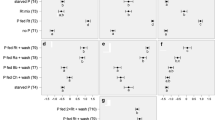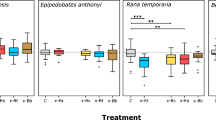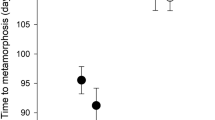Abstract
In aquatic environments, many prey rely on chemosensory information from injured (alarm cues) or stressed conspecifics (disturbance cues) to assess predation risk. Alarm cues are considered as a sign of higher risk than disturbance cues. These cues could be used by prey to learn potential new predators. In this study, we tested whether Iberian green frog tadpoles (Pelophylax perezi) exhibited antipredator responses to alarm and disturbance cues of conspecifics and whether tadpoles could associate new predators with alarm or disturbance cues. Tadpoles reduced their activity in the presence of disturbance cues, but only weakly when compared with their response to alarm cues. Also, tadpoles learned to recognize new predators from association with alarm or disturbance cues. However, the period of retention of the learned association was shorter for disturbance than alarm cues. Our results indicate that tadpoles are able to modify their antipredatory behavior according to (1) the degree of risk implied by the experimental cues (2) their previous experience of chemical cues of the predator.


Similar content being viewed by others
References
ASIH (2004) Guidelines for use of live amphibians and reptiles in field and laboratory research. Herpetological Animal Care and Use Committee (HACC) of the American Society of Ichthyologists and Herpetologists, Lawrence, Kansas
Bryer PJ, Mirza RS, Chivers DP (2001) Chemosensory assessment of predation risk by slimy sculpins (Cottus cognatus): responses to alarm, disturbance, and predator cues. J Chem Ecol 27:533–546
Chivers DP, Smith RJF (1998) Chemical alarm signaling in aquatic predator/prey interactions: a review and prospectus. Ecoscience 5:338–352
Chivers DP, Mirza RS, Bryer PJ, Kiesecker JM (2001) Threat-sensitive predator avoidance by slimy sculpins: understanding the role of visual versus chemical information. Can J Zool 79:867–873
Dukas R (2002) Behavioural and ecological consequences of limited attention. Philos Trans R Soc Lond B 357:1539–547
Ferrari MCO, Chivers DP (2006) Learning threat-sensitive predator avoidance: how do fathead minnows incorporate conflicting information? Anim Behav 71:19–26
Ferrari MCO, Vavrek MA, Elvidge CK, Fridman B, Chivers DP, Brown GE (2008) Sensory complementation and the acquisition of predator recognition by salmonid fishes. Behav Ecol Sociobiol 63:113–121
Gonzalo A, López P, Martín J (2007) Iberian green frog tadpoles may learn to recognize novel predators from chemical alarm cues of conspecifics. Anim Behav 74:447–453
Gonzalo A, López P, Martín J (2009) Learning, memorizing and apparent forgetting of chemical cues from new predators by Iberian green frog tadpoles. Anim Cogn 12:745–750
Gosner KL (1960) A simplified table for staging anuran embryos and larvae with notes on identification. Herpetologica 16:183–190
Grafen A, Hails R (2002) Modern statistics for the life sciences. Oxford University Press, Oxford
Hazlett BA (1985) Disturbance pheromones in the crayfish Orconectes virilis. J Chem Ecol 11:1695–1711
Hazlett BA (1989) Additional sources of disturbance pheromone affecting the crayfish Orconectes virilis. J Chem Ecol 15:381–385
Hazlett BA (1990a) Disturbance pheromone in the hermit crab Calcinus laevimanus (Randolf, 1840). Crustaceana 58:314–316
Hazlett BA (1990b) Source and nature of disturbance chemical system in crayfish. J Chem Ecol 20:2263–2275
Hazlett BA (2003) Predator recognition and learned irrelevance in the crayfish Orconectes virilis. Ethology 109:765–780
Helfman GS (1989) Threat-sensitive predator avoidance in damselfish–trumpetfish interactions. Behav Ecol Sociobiol 24:47–58
Hews DK (1988) Alarm response in larval western toads, Bufo boreas: release of larval chemicals by a natural predator and its effect on predator capture efficiency. Anim Behav 36:125–133
Hews DK, Blaustein AR (1985) An investigation of the alarm response in Bufo boreas and Rana cascadae tadpoles. Behav Neural Biol 43:47–57
Jordão LC (2004) Disturbance chemical cues determine changes in spatial occupation by the convict cichlid Archocentrus nigrofasciatus. Behav Process 67:453–459
Kats LB, Dill LM (1998) The scent of death: chemosensory assessment of predation risk by prey animals. Ecoscience 5:361–394
Kiesecker JM, Chivers DP, Marco A, Quilchano C, Anderson MT, Blaustein AR (1999) Identification of a disturbance signal in larval red-legged frogs, Rana aurora. Anim Behav 57:1295–1300
Mathis A, Smith RJF (1993) Fathead minnows, Pimephales promelas, learn to recognize northern pike, Esox lucius, as predators on the basis of chemical stimuli from minnows in the pike’s diet. Anim Behav 46:645–656
Mirza RS, Chivers DP (2002) Behavioural responses to conspecific disturbance chemicals enhance survival of juvenile brook charr, Salvelinus fontinalis, during encounters with predators. Behaviour 139:1099–1110
Pfeiffer W (1966) Die verbreitung der schreckreaktion bei kaulquappen und die herkunft des schreckstoffes. Z Vergl Physiol 52:79–98
Rohr JR, Madison DM (2001) A chemically mediated trade-off between predation risk and mate search in newts. Anim Behav 62:863–869
Smith RJF (1979) Alarm reaction of Iowa and Johnny darters (Etheostoma, Percidae, Pisces) to chemicals from injured conspecifics. Can J Zool 57:1278–1282
Smith RJF (1992) Alarm signals in fishes. Rev Fish Biol Fish 2:33–63
Sokal RR, Rohlf FJ (1995) Biometry. WH Freeman, New York
Turner AM, Turner SE, Lappi HM (2005) Learning, memory and predator avoidance by freshwater snails: effects of experience on predator recognition and defensive strategy. Anim Behav 72:1443–1450
van der Veen IT (2002) Seeing is believing: information about predators influences yellowhammer behavior. Behav Ecol Sociobiol 51:466–471
Wilson DJ, Lefort H (1993) The effect of predator diet on the alarm response of red-legged frog, Rana aurora, tadpoles. Anim Behav 46:1017–1019
Wisenden BD (2000) Olfactory assessment of predation risk in the aquatic environment. Philos Trans R Soc Lond B 355:1205–1208
Wisenden BD, Chivers DP, Smith RJF (1995) Early warning of risk in the predation sequence: a disturbance pheromone in Iowa darters (Etheostoma exile). J Chem Ecol 21:1469–1480
Woody DR, Mathis A (1998) Acquired recognition of chemical stimuli from an unfamiliar predator: associative learning by adult newts, Notophthalmus viridescens. Copeia 1998:1027–1031
Acknowledgments
We thank Carlos Cabido and two referees for helpful comments, Dr. William Cooper for his valuable help with the English, and ‘El Ventorrillo’ MNCN Field Station for the use of their facilities. Financial support was provided by a MEC-FPU grant to A.G. and by the projects MEC-CGL2005-00391/BOS and MCI-CGL2008-02119/BOS.
Author information
Authors and Affiliations
Corresponding author
Additional information
Communicated by: J. Christensen-Dalsgaard
Rights and permissions
About this article
Cite this article
Gonzalo, A., López, P. & Martín, J. Risk level of chemical cues determines retention of recognition of new predators in Iberian green frog tadpoles. Behav Ecol Sociobiol 64, 1117–1123 (2010). https://doi.org/10.1007/s00265-010-0927-y
Received:
Revised:
Accepted:
Published:
Issue Date:
DOI: https://doi.org/10.1007/s00265-010-0927-y




